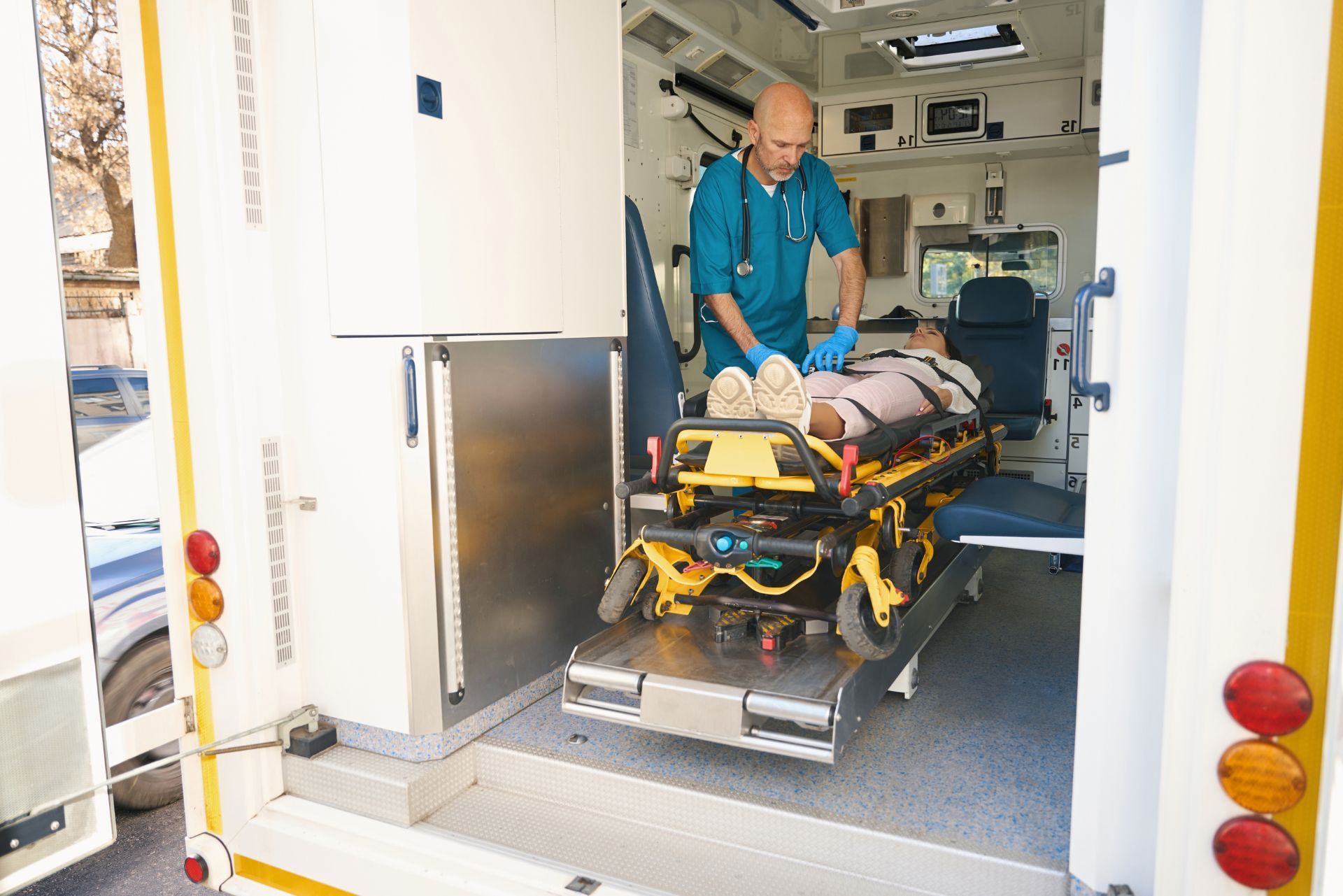Top 3 Recommended Policies

In the realm of healthcare, ensuring that patients receive timely and safe transportation to medical facilities is crucial. Indiana medical transport insurance plays a significant role in this process, providing coverage for various types of transport services. This article aims to explore the intricacies of medical transport insurance in Indiana, including its importance, types, coverage options, and how to choose the right policy.
Understanding Medical Transport Insurance
Medical transport insurance is designed to cover the costs associated with transporting patients who require medical attention. This can include emergency ambulance services, non-emergency medical transportation (NEMT), and air ambulance services. The primary goal of this insurance is to ensure that patients can access necessary medical care without the burden of high transportation costs.
Why Medical Transport Insurance is Essential
Access to medical care is a fundamental right, yet many individuals face barriers when it comes to transportation. Medical transport insurance provides a safety net, ensuring that patients can reach healthcare providers when they need to. This is particularly important for those with chronic conditions, disabilities, or those who live in rural areas where medical facilities may be far away.
Moreover, medical transport insurance can alleviate financial stress. Without coverage, the costs associated with ambulance rides or other forms of medical transport can be exorbitant, leading to significant out-of-pocket expenses for families. By having insurance, patients can focus on their health rather than worrying about financial implications.
In addition to the financial benefits, medical transport insurance also plays a crucial role in enhancing patient outcomes. Timely access to medical care can significantly affect recovery rates, especially in emergencies where every minute counts. For instance, in the case of a heart attack or stroke, rapid transport to a hospital can be the difference between life and death. Insurance coverage ensures that patients can receive the urgent care they need without delay, which can ultimately lead to better health results and lower overall healthcare costs in the long run.
Furthermore, the landscape of medical transport is evolving with advancements in technology. Telemedicine and mobile health applications are increasingly being integrated into transport services, allowing for better coordination between patients, transport providers, and healthcare facilities. This integration not only streamlines the process but also enhances the quality of care provided during transport. Patients can receive preliminary assessments and guidance from healthcare professionals while en route, ensuring that they are stabilized and prepared for treatment upon arrival. As these innovations continue to develop, having comprehensive medical transport insurance becomes even more critical for ensuring that patients can take full advantage of these services.
Types of Medical Transport Services Covered
Indiana medical transport insurance typically covers several types of transport services, each designed to meet different patient needs. Understanding these services can help individuals select the right coverage for their specific circumstances.
Emergency Ambulance Services
Emergency ambulance services are perhaps the most recognized form of medical transport. These services are utilized in critical situations where immediate medical attention is required. Insurance policies often cover the costs associated with emergency transport, which can include advanced life support and basic life support services.
In Indiana, emergency ambulance services are usually dispatched through 911 calls, and the costs can vary significantly based on distance, the level of care required, and the specific ambulance service provider. Having insurance that covers these costs can be a lifesaver in emergencies. Additionally, many ambulance services are equipped with advanced medical technology and staffed by trained professionals who can provide critical care en route to the hospital, ensuring that patients receive the necessary treatment as quickly as possible.
Non-Emergency Medical Transportation (NEMT)
Non-emergency medical transportation is designed for patients who need assistance getting to medical appointments but do not require immediate medical attention. This can include rides to routine check-ups, physical therapy sessions, or specialist visits. NEMT is particularly beneficial for individuals who may have mobility issues or lack access to reliable transportation.
Insurance coverage for NEMT can vary, with some policies offering comprehensive coverage while others may have limitations. Understanding the specifics of your policy is essential to ensure that you can access the necessary transportation when needed. Moreover, many NEMT providers offer additional services such as door-to-door assistance and wheelchair-accessible vehicles, making it easier for patients to attend their appointments without the stress of navigating transportation challenges.
Air Ambulance Services
In situations where ground transport is not feasible or would significantly delay treatment, air ambulance services come into play. These services are typically used for critically ill patients or those in remote locations. Air ambulance transport is often more expensive than ground transport, making insurance coverage crucial.
When considering air ambulance coverage, it’s important to check whether your policy includes this service and under what circumstances it can be utilized. Some policies may require prior authorization or have specific conditions that must be met. Furthermore, air ambulances are equipped with state-of-the-art medical equipment and staffed by highly trained medical personnel, including paramedics and nurses, who can provide life-saving interventions during flight. This level of care is essential for patients needing urgent medical attention, especially in cases of severe trauma or life-threatening conditions where every second counts.

Key Coverage Options to Consider
When selecting a medical transport insurance policy in Indiana, it’s vital to understand the various coverage options available. Each option can significantly impact the level of care and financial protection provided.
In-Network vs. Out-of-Network Providers
Insurance policies often differentiate between in-network and out-of-network providers. In-network providers have agreements with the insurance company to offer services at reduced rates. Choosing an in-network ambulance service can result in lower out-of-pocket costs for patients.
On the other hand, using an out-of-network provider may lead to higher expenses. It’s crucial to verify which providers are in-network and consider this when selecting a policy to avoid unexpected costs. Additionally, some insurance companies may require pre-authorization for out-of-network services, which can complicate the process and delay necessary care. Being proactive in understanding your insurance network can save you both time and money in critical situations.
Coverage Limits and Deductibles
Like any insurance policy, medical transport insurance comes with coverage limits and deductibles. Coverage limits refer to the maximum amount the insurance will pay for services, while deductibles are the amount the insured must pay out-of-pocket before the insurance kicks in.
Understanding these terms is essential for ensuring that the policy meets your needs. Policies with lower deductibles may have higher premiums, so it’s important to find a balance that works for your financial situation. Moreover, some policies may have specific limits on types of transport, such as air ambulances versus ground transport, which can significantly affect your choice if you anticipate needing specialized services. Being aware of these nuances can help you make informed decisions and avoid surprises when you need care the most.
Additional Benefits
Some insurance policies may offer additional benefits, such as coverage for wheelchair transportation or specialized transport for patients with specific medical needs. These additional services can enhance the value of a policy, making it more comprehensive.
When evaluating different policies, consider what additional benefits may be important for your situation. This can help ensure that you receive the best possible care and support during medical transport. For instance, some policies might include coverage for non-emergency medical transportation, which can be crucial for patients who require regular visits to healthcare providers but do not need immediate emergency services. Additionally, look for options that provide access to telehealth services, as these can complement your transport needs by facilitating consultations without the necessity of physical travel. Understanding the full range of benefits can empower you to choose a policy that truly meets your healthcare requirements.
Choosing the Right Medical Transport Insurance
Selecting the right medical transport insurance can be a daunting task, especially with the variety of options available. However, with careful consideration and research, individuals can find a policy that meets their needs.
Assessing Personal Needs
The first step in choosing medical transport insurance is to assess personal needs. Consider factors such as existing medical conditions, frequency of medical appointments, and the distance to healthcare facilities. This information can help determine the level of coverage required.
For individuals with chronic illnesses or disabilities, comprehensive coverage may be necessary to ensure that transportation to appointments is readily available. On the other hand, those who only require occasional transport may opt for a more basic policy.
Additionally, it’s important to consider the type of transport needed. Some individuals may require specialized vehicles equipped for wheelchairs or other medical equipment, while others may simply need standard transport services. Understanding these nuances can significantly impact the choice of insurance, as not all policies will cover specialized transport needs.
Comparing Policies
Once personal needs have been assessed, it’s time to compare different insurance policies. Look at the coverage options, premiums, deductibles, and any additional benefits offered. Online comparison tools can be helpful in evaluating multiple policies side by side.
It’s also advisable to read customer reviews and testimonials to gauge the reliability and customer service of different insurance providers. This can provide valuable insights into how the company handles claims and customer support.
Moreover, pay attention to the network of providers associated with each policy. Some insurance plans may have partnerships with specific transport companies, which can affect the quality and availability of services. Ensuring that your preferred transport service is included in the network can save time and stress during medical emergencies.
Consulting with Experts
When in doubt, consulting with insurance experts or brokers can provide additional guidance. These professionals can help navigate the complexities of medical transport insurance and recommend policies that align with individual needs and budgets.
Insurance brokers often have access to a wide range of policies and can provide personalized recommendations based on specific circumstances. Their expertise can be invaluable in making an informed decision.
In addition to brokers, consider reaching out to healthcare providers for recommendations on insurance options. Many healthcare professionals are familiar with the intricacies of medical transport and may have insights into which insurance policies are most beneficial for their patients. They can often point you toward plans that have proven effective for others in similar situations, further aiding in the decision-making process.
Understanding the Claims Process
Once a medical transport insurance policy has been selected, understanding the claims process is essential. Knowing how to file a claim and what information is required can streamline the process and ensure that patients receive the benefits they are entitled to. A well-informed policyholder is better equipped to navigate the complexities of insurance, which can often feel overwhelming, especially during times of medical need.
Filing a Claim
Filing a claim typically involves submitting a claim form along with any necessary documentation, such as transport receipts and medical records. Each insurance provider may have its own specific requirements, so it’s important to review the policy documentation for detailed instructions. Additionally, keeping a personal record of all communications with the insurance company can be beneficial, as it provides a timeline and context for any future inquiries or disputes.
In many cases, the ambulance service provider may assist in filing the claim, especially if they are in-network. However, patients should remain proactive and ensure that all required information is submitted to avoid delays. It can be helpful to follow up with the insurance company after submitting the claim to confirm that it has been received and is being processed. This proactive approach can help identify any potential issues early on, allowing for quicker resolution.
Claim Denials and Appeals
Unfortunately, claims can sometimes be denied for various reasons, such as lack of coverage or insufficient documentation. If a claim is denied, it’s important to understand the reasons behind the denial and explore the appeals process. Familiarizing oneself with the common reasons for denials can help in preparing a more robust claim in the future. It’s also advisable to consult with a representative from the insurance company who can provide clarity on the specific reasons for the denial.
Most insurance companies have a formal appeals process that allows policyholders to contest a denial. This typically involves submitting additional documentation or clarification to support the claim. Being persistent and thorough can often lead to a successful appeal. Furthermore, gathering supporting letters from healthcare providers can strengthen the case, as these professionals can provide insights into the necessity of the transport and the urgency of the medical situation. Engaging in this process not only aids in securing benefits but also empowers patients by giving them a clearer understanding of their rights and options within the healthcare system.

Future Trends in Medical Transport Insurance
The landscape of medical transport insurance is continually evolving, influenced by changes in healthcare policies, technology, and patient needs. Understanding these trends can help individuals stay informed and make better decisions regarding their insurance coverage.
Telehealth and Virtual Transport Services
With the rise of telehealth, there is a growing trend toward virtual transport services. These services aim to provide remote consultations and follow-ups, reducing the need for physical transportation. While this may not replace traditional medical transport, it can complement existing services and enhance patient care.
Insurance policies may begin to adapt to cover telehealth services, potentially impacting the need for physical transport. Keeping an eye on these developments can help individuals stay ahead of the curve.
Increased Focus on Patient-Centered Care
As healthcare continues to shift toward patient-centered care, there is an increased emphasis on ensuring that patients have access to the services they need. This includes transportation to medical appointments. Insurance providers may respond by offering more flexible and comprehensive coverage options to meet the diverse needs of patients.
Advancements in technology may also play a role in improving the efficiency and effectiveness of medical transport services, leading to better patient outcomes and satisfaction.
Conclusion
Indiana medical transport insurance is a vital component of the healthcare system, ensuring that patients can access necessary medical services without the burden of high transportation costs. By understanding the types of coverage available, assessing personal needs, and staying informed about industry trends, individuals can make informed decisions regarding their insurance policies.
As the landscape of healthcare continues to evolve, remaining proactive and engaged in the insurance selection process will help ensure that individuals receive the best possible care when they need it most. Whether it’s emergency ambulance services, non-emergency medical transportation, or air ambulance services, having the right insurance coverage can make all the difference in accessing timely medical care.
Contact Us

